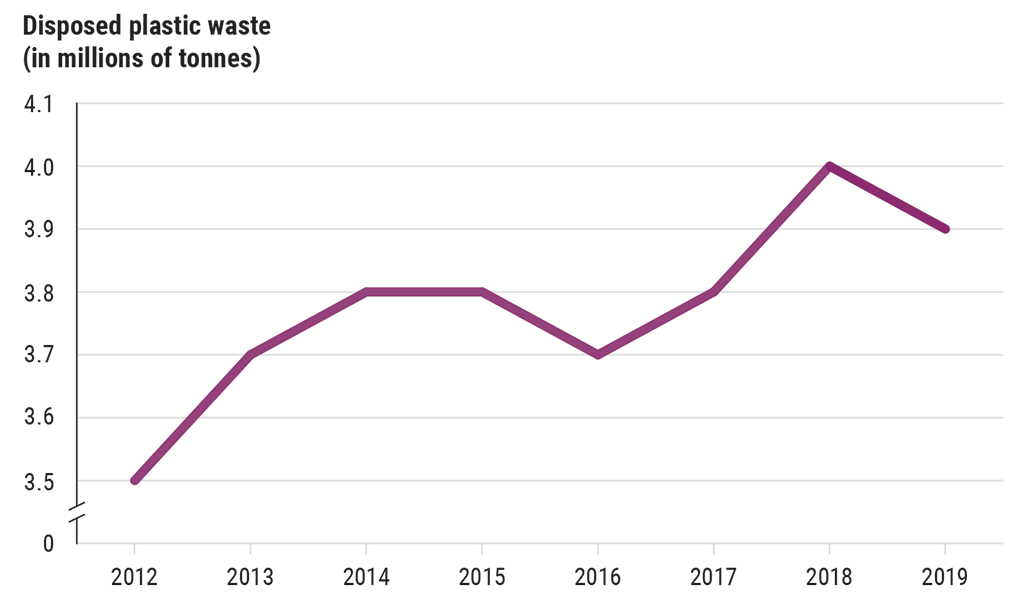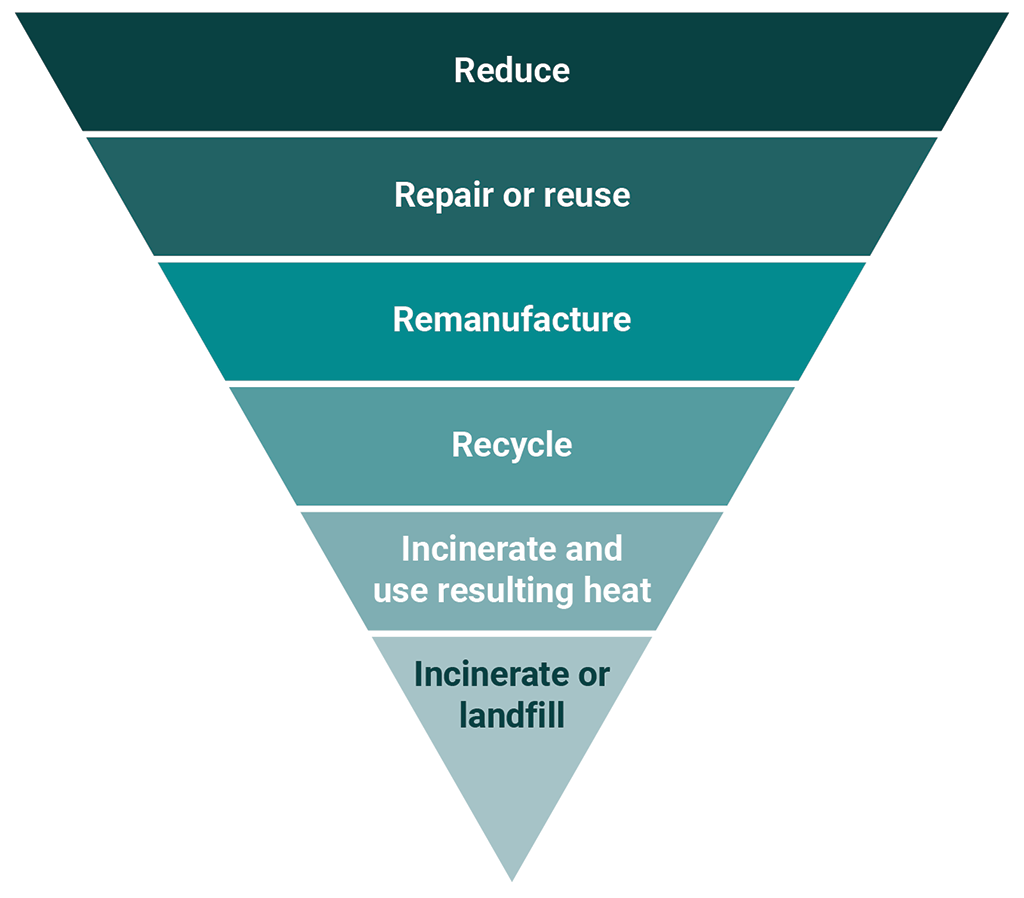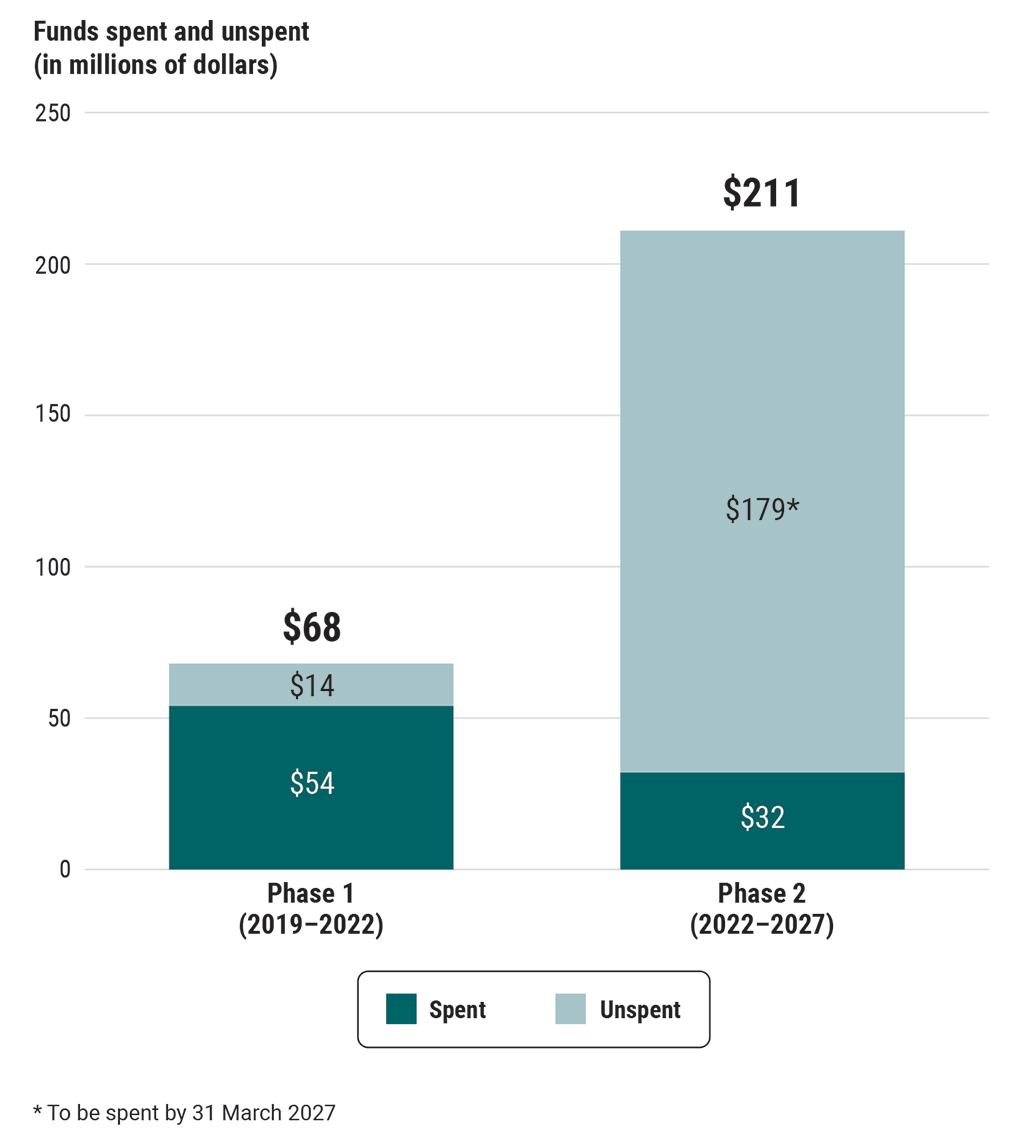2024 Reports 1 to 5 of the Commissioner of the Environment and Sustainable Development to the Parliament of Canada
Report 3—Zero Plastic Waste
At a Glance
In 2019, key federal organizations led by Environment and Climate Change Canada launched the zero plastic waste horizontal initiative to keep plastics in use in the economy and out of the environment by 2030. Despite this name, the initiative set targets for reducing plastic waste instead of aiming to reach the zero plastic waste goal of the joint federal, provincial, and territorial Canada‑wide Strategy on Zero Plastic Waste. We found that all the audited key organizations had begun implementing activities to which they had committed under the initiative, but a lack of information needed on plastic waste did not yet allow them to know whether their activities would be a sufficient contribution to achieve the 2030 goal of the joint Canada‑wide strategy.
We found that 11 of the 16 waste-reduction activities we examined were delivering good results and were strongly aligned with Canada’s priorities on zero plastic waste. For instance, Fisheries and Oceans Canada funded 67 projects that were removing abandoned, lost, and discarded fishing gear from the water. The remaining 5 activities were still under development, setting clear action plans and deliverables. For example, Environment and Climate Change Canada was developing a federal public plastics registry to standardize data around plastics, making information more available to Canadians.
However, important information was missing from the initiative’s performance measurement framework, which affected Environment and Climate Change Canada’s ability to measure how activities contributed to the Canada‑wide goal. For example, information on the amount of plastic waste that is leaked into the environment was incomplete. Environment and Climate Change Canada also did not have a clear idea of the risks that could affect the initiative, and federal organizations did not know whether their risk-reduction actions were having any effect. All these elements resulted in decision makers not knowing whether they were on the right track and whether they needed to take corrective actions, increasing the chances of waste-reduction activities not meeting the 2030 goal.
Key facts and findings
- As of March 2023, from 2012 to 2018, plastic waste in Canada increased by 15% from 3.5 million tonnes to 4 million tonnes per year.
- In 2019, Canada had similar rates of treating plastic waste and recycling as the other Organisation for Economic Co‑operation and Development countries. However, Canada landfills a higher proportion of its waste compared with other member countries that incinerate much more of their plastic waste.
- The initiative is the federal government’s contribution to the joint federal, provincial, and territorial Canada-wide Strategy on Zero Plastic Waste, in which the federal government is only one of the players in the reduction of plastic waste. The federal government needs to collaborate with partners, such as provinces, territories, municipalities, and the private sector, to achieve zero plastic waste by 2030.
- We found that the governance structure established for the initiative by Environment and Climate Change Canada had clear roles and responsibilities to manage decision making.
- There was a 3‑year-and-3‑month lag in plastic waste data availability from Statistics Canada, which means the next annual report expected in March 2024 will present data only up to 2020.
- Environment and Climate Change Canada had no clear data framework to respond to data and knowledge gaps.
Why we did this audit
- On land and sea, species can get tangled in plastic waste and die of starvation or choke on the waste itself. Wildlife can also die as a result of ingesting plastic waste. Plastics contaminate food chains and weaken the resilience of ecosystems.
- The amount of waste being generated and the ambitious goal of zero plastic waste makes it crucial for the department to coordinate effectively with key federal stakeholders so that the initiative could proceed.
- Not measuring the horizontal initiative’s progress toward zero plastic waste would result in decision makers not knowing whether they are on the right track and whether they need to take corrective actions.
Highlights of our recommendations
- To have more information about results and determine whether it is using the right tools to reduce plastic waste, Environment and Climate Change Canada should develop a data framework to compile existing information‑gathering initiatives and identify the gaps in the information to measure progress toward the 2030 zero plastic waste goal.
- Environment and Climate Change Canada should consolidate the results of the completed risk identification and communicate them among the partners in accordance with the risk management framework required by the Treasury Board of Canada Secretariat.
- Environment and Climate Change Canada, Fisheries and Oceans Canada, Crown-Indigenous Relations and Northern Affairs Canada, and Statistics Canada should put mechanisms in place to monitor the effectiveness of risk responses. This should include target dates for tracking progress on the completion of risk responses.
Please see the full report to read our complete findings, analysis, recommendations and the audited organizations’ responses.
Exhibit highlights
Plastic waste in Canada from 2012 to 2019

Source: Based on data from Statistics Canada, March 2023
Text version
This line graph shows the increase in the amount of disposed plastic waste in Canada from 2012 to 2019 in millions of tonnes.
In 2012, approximately 3.5 million tonnes of plastic was disposed of. That amount rose to 3.7 million tonnes in 2013 and to 3.8 million tonnes in both 2014 and 2015. It fell to 3.7 million tonnes in 2016 before rising again to 3.8 million tonnes in 2017 and then to 4.0 million tonnes in 2018. It fell to 3.9 million tonnes in 2019.
Ways to manage plastic waste from least to most harmful to the environment

Source: Adapted from information provided by Environment and Climate Change Canada
Text version
This list of ways to manage plastic waste from least to most harmful to the environment forms an inverted triangle. It shows the following management options in order from least to most harmful:
- Reduce
- Repair or reuse
- Remanufacture
- Recycle
- Incinerate and use resulting heat
- Incinerate or landfill
As of 31 March 2023, $86 million of the total initiative funding of $279 million had been spent to carry out activities

Source: Based on information from Environment and Climate Change Canada
Text version
This bar graph shows the amount of spent and unspent initiative funding for phase 1 (2019 to 2022) and phase 2 (2022 to 2027) as of 31 March 2023.
Of the $68 million of funding for phase 1, $54 million was spent and $14 million was unspent.
Of the $211 million of funding for phase 2, $32 million was spent and $179 million was unspent but is to be spent by 31 March 2027.
Infographic

Text version
Zero Plastic Waste
Canada’s zero plastic waste horizontal initiative aims to keep plastic out of the environment and in use within the economy by 2030.
In 2016, 30% of plastic products were reduced, repaired or reused, remanufactured, or recycled, while 70% went into landfills or incinerators.
The 2030 goal is for 100% of plastic products to be reduced, repaired or reused, remanufactured, or recycled.
The initiative has begun achieving results:
- There are 61 research and monitoring projects underway to detect plastics in the environment.
- There are 67 projects that are removing abandoned, lost, and discarded fishing gear from the water.
- There are 5 projects that are developing new technologies to reduce plastic waste from the textile industry.
- There is 1 project that is developing standards for sustainable plastic.
Key players need to better gather information and track the performance of the initiative to be able to say whether they are on track:
- How much plastic is there in the environment now? A data framework could help answer this question.
- By how much are projects reducing plastic waste? A better performance measurement framework could help answer this question.
- Are the projects contributing to meeting the 2030 goal? Better monitoring and reporting could help answer this question.
Without data on plastic waste, Environment and Climate Change Canada does not yet have the key information it needs to ensure it will meet the 2030 goal.
Related information
Entities
Tabling date
- 30 April 2024
Related audits
- 2018 Reports of the Commissioner of the Environment and Sustainable Development
Report 1—Toxic Substances
